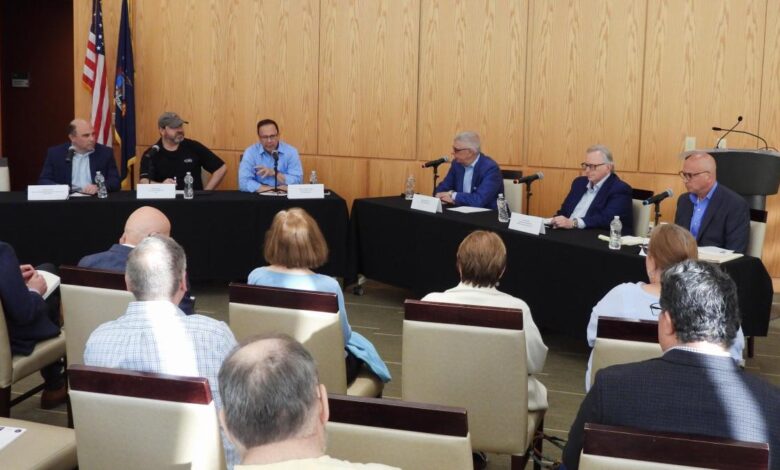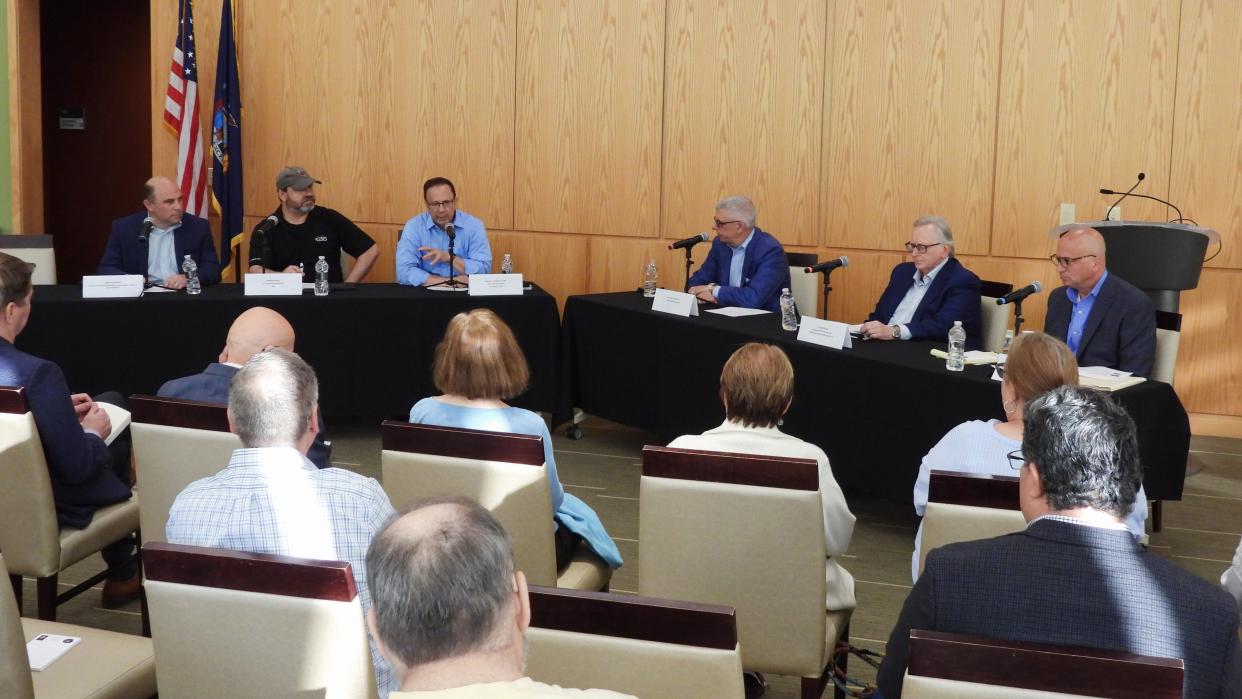Oneida County officials discuss artificial intelligence

Artificial intelligence has advanced far beyond the days of Garry Kasparov and the chess-playing computer Deep Blue. With many positives, negatives, fears, and misinformation swirling around it, local officials and experts recently sat down with Oneida County residents to help set the record straight.
At Mohawk Valley Community College’s Rome Campus, State Sen. Joseph Griffo, R-Rome, and Oneida County Executive Anthony Picente Jr. were joined by four experts on Thursday, May 23, to offer their points of view on AI.
Experts included Anthony Martino, director of Northeast Cybersecurity and Forensics Center at Utica University, Charles Green, co-founder, president, and CEO of Assured Information Security, Inc., Dr. Andy Drozd, president, CEO, and chief scientist at ANDRO Computational Solutions, LLC, and Stephen Acquario, Executive Director of New York State Association of Counties (NYSAC) and member of the National Association of Counties Artificial Intelligence Exploratory Committee.
Around 50 people from the community joined the conversation.

‘Premiere place for AI’
Griffo said as part of Gov. Kathy Hochul’s State of the State address, New York is being prepared to be the “…premiere place for AI to do research and development.”
“For me, as well as the county executive, we need to have a better grasp of AI because we’re going to be looking at legislation potentially,” he said. “And I want to hear from those in the field and those in the public. There’s a unique opportunity here, and while we shouldn’t fear it, we should be educated and aware.”
Picente agreed, echoing the senator’s sentiments, as well as, the importance of safeguarding communities and the people who might be impacted by artificial intelligence.
What is AI?
Martino said a lot of technology is being labeled as artificial intelligence, whether it is or not. He compared it to going to a grocery store and finding labels on everything that says ‘natural’ or ‘nutritious.’
“It’s on everything,” he said. “And a lot of entities are co-opting this word.”
Drozd described artificial intelligence as a technology that trains machines to think as humans do, just faster.
“It’s the opportunity to take enormous amounts of data, way more than any human could in a lifetime, and distill it down and hand it to you as a legitimate answer that’s contextual and useful in under a second,” Martino said. “It’s transformative.”
Green said artificial intelligence is not new — it’s been around for around 50 years now. It’s built on recognizing patterns and one of the biggest changes in AI technology are “large language” models, capable of mimicking human speech.
He cited ChatGPT as an example of this kind of AI. And, as is well known now, ChatGPT and other AI models are not infallible.
“These days, AI is driven by amassing all of this data from various sources,” Drozd said. “But an issue we face is that means you’re scraping data sources out there and using it to train these machines. But there’s an old adage: garbage in, garbage out.”
Drozd alluded to the fact that artificial intelligence is only as good as the data it’s being fed and can still commit errors.
However, with competent, well-maintained AI, the group discussed the benefits that local, county, and state governments can reap from it.
What are some uses of artificial intelligence?
When asked for a concrete example of something artificial intelligence is used for today, Drozd said when you browse on the internet, websites capture how people browse, how they click, and what they want, capturing it to tailor itself to the user better.
“It matches it back in real-time, pretty much,” he said.
Generative artificial intelligence uses the available information and attempts to offer solutions based on the scenario presented.
Acquario gave an example of having three ingredients in the refrigerator and asking the AI what dinner they could make from those three ingredients.
“Government has lots of data sources,” Acquario said. “Medicaid, social services, child welfare, property tax collection, appraisal of homes, and so much more. There are massive amounts of data, and these systems can comb through the data and produce reports for humans to use.”
But while some are excited about the possibilities of artificial intelligence, others are wary.
Public comment
One local resident in the audience talked about intellectual property issues and how artificial intelligence collects data from everyone on the internet, including from sources that some say should be protected.
“There’s a movement right now to say that the data collected on you is owned by you,” Martino said. “And there’s a current push to get these big data companies to have to pay you to use your data.”
“There’s personal intellectual property,” Drozd continued. “You’re creating it yourself, and you own it. Someone’s accessing it, but it’s your personal property. That’s a new kind of concept emerging right now.”
Another resident, a former teacher, discussed how prolific ChatGPT is being used for schoolwork and if there were any safeguards against it.
Drozd said much like there were services to check for plagiarism, there are now services for teachers and professors to check for artificial intelligence.
However, Picente said that in some cases, artificial intelligence doesn’t know what it’s talking about in works when viewed by someone familiar with the subject. Or, in this case, the town.
Picente said in one case; he observed ChatGPT attempt to write a press release for a local event, and while it started out strong, it began to write about things that just weren’t happening or didn’t exist.
Keeping an eye on AI
Artificial intelligence, while a powerful tool, is one that both Picente and Griffo wish to see utilized in a safe manner.
“There are plenty of benefits to artificial intelligence, but there are some potential risks and also problems like deep fakes and voice cloning,” Griffo said. “We’re going to have to monitor artificial intelligence and while I have my concerns, we have to try and engage. We’re talking with experts in the industry and continue to determine and ascertain this technology.”
Picente said more than anything, he’d like to see artificial intelligence used at the county and local level to help deliver services and provide for the people of Oneida County.
“I don’t think I want to see it used on the human services and public safety side, but making governments more efficient in terms of internal operations? That’s where I think the focus should be,” he said.
This article originally appeared on Observer-Dispatch: Oneida County officials and experts discuss artificial intelligence



